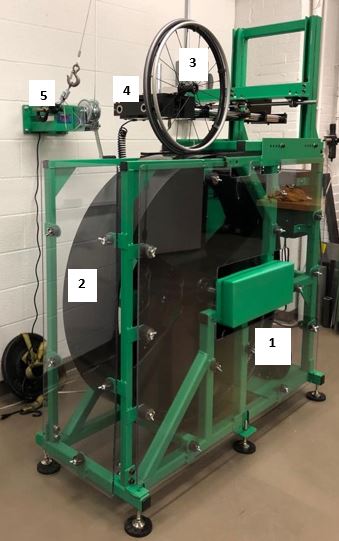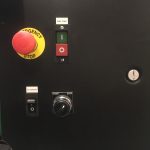Background edits
Rolling resistance is a force that detracts from manual wheelchair propulsion due to changes in the contact patch, hysteresis (elastic deformation), and load on the tire. Overtime, rolling resistance can contribute to upper extremity pain and injuries. In the future, the testing conducted with this machine should provide a comprehensive understanding of how setup factors influence rolling resistance.
The information will be provided to manufacturers to improve tire, wheel, and caster development. Furthermore, clinicians will have a reference guide for how the setup of the device will impact the user’s propulsion and reduce the prevalence of upper extremity pain and injuries.
Purpose
To accurately categorize and measure rolling resistance, this machine was developed to measure it on a component level to test the factors of toe, camber, load, tire pressure, tire type, caster type, and surfaces.
Principle
The drum is spun at a constant speed while the air bushing slide on the parallel rods. A load cell captures the force pulling the air bushings and thus, rolling resistance.
Apparatus


Figure 1. Rolling Resistance Machine.
1. Frame (lower assembly), 2. Drum, 3. Wheel (can be replaced with a caster), 4. Truck, 5. Winch, 6. Frame (Upper assembly), 7. Emergency stop, 8. Main power, 9. Air supply switch.
The Rolling Resistance machine consists of:
- Frame (Lower assembly): Supports main components such as the motor, bands, and the drum.
- Drum. The drum is sped at a constant speed throughout the test to allow different factors to be evaluated for a wheel or caster.
- Wheel or caster.
- Truck. The truck houses the air bushings, and it is the component in which the load, the toe, and the camber can be set.
- Winch. It raises and lowers the truck. This is used during test set up and at the end of the test.
- Frame (Upper assembly). It supports the truck and helps to level the system for testing.
- Emergency stop. This button is located in the main control box and closer to the operator to stop the entire machine.
- Main power. Electric power supply.
- Air supply switch. For testing, it needs to be activated each time a test is set and ready to start.
Test set up
This machine has the flexibility to test several parameters for casters and wheels. To test the casters and wheels under certain conditions this machine can change camber, toe, load, tire pressure (if applicable), and surface.
Each parameter has a specific set up and it can be used in combination with other parameters. For instance, toe 1°, camber 0°, 50 lb of load, 100% tire pressure, and carpet as a testing surface.
For further information about the set up for each parameter. Download Test Set up.
A standard condition is considered to be as follows: Toe at 0°, Camber at 0°, and maximum tire pressure.
Test method
The total amount for a single test and data collection is about 2 minutes. However, considering this machine requires each parameter to be set up before proceeding with the test.
For this reason, we recommend you review the Test set up for a detailed procedure on this test.
Check the video of the Rolling Resistance machine performing a test:
Acknowledgments
Joe Ott, PhD for the information and support provided to put this together.





